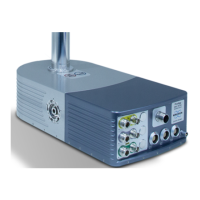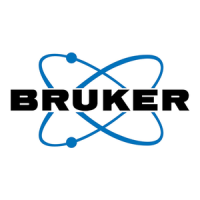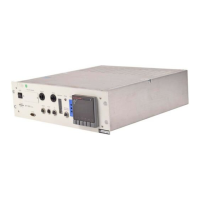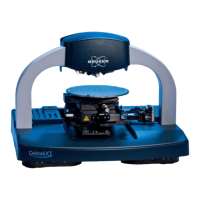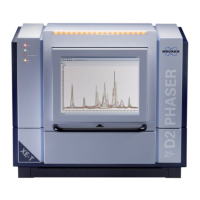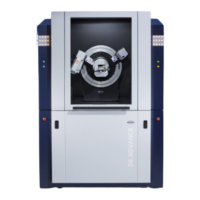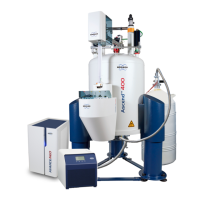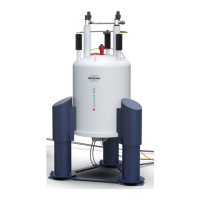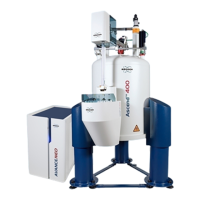Do you have a question about the Bruker CryoProbe and is the answer not in the manual?
Defines warning symbols, safety labels, and their meanings.
BRUKER's liability for system usage and manual errors.
Describes the EMERGENCY OFF function and its consequences.
Outlines safety requirements for personnel operating the system.
Details precautions for handling and operating CryoProbe components safely.
Provides immediate actions for exposure to cold helium gas.
Guidance on navigating the user manual and finding information.
Introduces the main components of the CryoProbe System.
Explains formatting conventions used in the manual for clarity.
Details the CryoProbe itself and its core functions.
Describes the CryoPlatform infrastructure and its key subsystems.
Explains the cryogenic cooling cycle and its mechanics.
Covers the software for system control and monitoring.
Essential document for safe operation and preventing damage.
Guidelines for safely handling the delicate CryoProbe components.
Step-by-step instructions for installing the CryoProbe into the magnet.
Procedure to verify if the sample can be spun correctly.
Instructions for connecting the He Transferline to the CryoProbe.
Steps to connect sensor cables, VT gas, and other interfaces.
Detailed steps for powering up the entire CryoProbe System.
Configuration of the Variable Temperature (VT) gas system for sample control.
Procedures and checks for initiating the cryogenic cooling process.
How to configure the hardware settings for the HPPR CRP.
Determining the minimum achievable temperature for experiments.
Process for optimizing RF circuit performance at cryogenic temperatures.
Procedures for achieving optimal spectral resolution and signal lock.
Instructions for warming the CryoProbe to ambient temperature.
Step-by-step guide for safely removing the CryoProbe from the magnet.
Steps to safely shut down the CryoProbe System.
How to use conventional probes with a CryoProbe-equipped spectrometer.
Covers general experimental advice, sample types, and temperature control basics.
Details RF power limits, preamplifier usage, and pulse sequence precautions.
Discusses receiver settings, shimming, solvent suppression, and automation.
Explains how to interpret system indicators and use diagnostic tools.
Covers periodic system checks and the importance of maintaining logs.
Details tasks like He cylinder replacement, software updates, and cleaning.
Critical actions for immediate safety and system shutdown.
Steps for identifying issues before contacting support.
Covers common issues like power, vacuum, compressor, and cool-down failures.
Addresses problems occurring during cryogenic operation, including temperature and gas flow.
Troubleshooting RF transmission, tuning, matching, and signal lock issues.
Guidance on rectifying common user errors and incorrect procedures.
Contact details for sales, service, and reporting issues.
Lists additional documentation for further information.
Provides conversion factors for various units.
Answers questions about probe types, magnet compatibility, and space requirements.
Addresses questions on experimental restrictions, parameter sensitivity, and performance.
Explains basic concepts like signal-to-noise and user repairability.
Definitions of technical terms used throughout the manual.
Defines warning symbols, safety labels, and their meanings.
BRUKER's liability for system usage and manual errors.
Describes the EMERGENCY OFF function and its consequences.
Outlines safety requirements for personnel operating the system.
Details precautions for handling and operating CryoProbe components safely.
Provides immediate actions for exposure to cold helium gas.
Guidance on navigating the user manual and finding information.
Introduces the main components of the CryoProbe System.
Explains formatting conventions used in the manual for clarity.
Details the CryoProbe itself and its core functions.
Describes the CryoPlatform infrastructure and its key subsystems.
Explains the cryogenic cooling cycle and its mechanics.
Covers the software for system control and monitoring.
Essential document for safe operation and preventing damage.
Guidelines for safely handling the delicate CryoProbe components.
Step-by-step instructions for installing the CryoProbe into the magnet.
Procedure to verify if the sample can be spun correctly.
Instructions for connecting the He Transferline to the CryoProbe.
Steps to connect sensor cables, VT gas, and other interfaces.
Detailed steps for powering up the entire CryoProbe System.
Configuration of the Variable Temperature (VT) gas system for sample control.
Procedures and checks for initiating the cryogenic cooling process.
How to configure the hardware settings for the HPPR CRP.
Determining the minimum achievable temperature for experiments.
Process for optimizing RF circuit performance at cryogenic temperatures.
Procedures for achieving optimal spectral resolution and signal lock.
Instructions for warming the CryoProbe to ambient temperature.
Step-by-step guide for safely removing the CryoProbe from the magnet.
Steps to safely shut down the CryoProbe System.
How to use conventional probes with a CryoProbe-equipped spectrometer.
Covers general experimental advice, sample types, and temperature control basics.
Details RF power limits, preamplifier usage, and pulse sequence precautions.
Discusses receiver settings, shimming, solvent suppression, and automation.
Explains how to interpret system indicators and use diagnostic tools.
Covers periodic system checks and the importance of maintaining logs.
Details tasks like He cylinder replacement, software updates, and cleaning.
Critical actions for immediate safety and system shutdown.
Steps for identifying issues before contacting support.
Covers common issues like power, vacuum, compressor, and cool-down failures.
Addresses problems occurring during cryogenic operation, including temperature and gas flow.
Troubleshooting RF transmission, tuning, matching, and signal lock issues.
Guidance on rectifying common user errors and incorrect procedures.
Contact details for sales, service, and reporting issues.
Lists additional documentation for further information.
Provides conversion factors for various units.
Answers questions about probe types, magnet compatibility, and space requirements.
Addresses questions on experimental restrictions, parameter sensitivity, and performance.
Explains basic concepts like signal-to-noise and user repairability.
Definitions of technical terms used throughout the manual.
| Vendor | Bruker BioSpin |
|---|---|
| Compatibility | Bruker NMR spectrometers |
| Solvent Suppression | Advanced solvent suppression techniques available |
| Probe Type | Cryogenic probe |
| Sensitivity | Significantly higher than room temperature probes |
| Cooling System | Helium-based cryogenic system |
| Applications | Metabolomics |
| Technology | Cryogenic cooling of RF coils and preamplifiers |
| Sample Type | Liquid samples |
| Nuclei Supported | 1H, 13C, 15N |
| Salt Tolerance | High salt tolerance |
| Automation | Compatible with automated sample changers |
| Dynamic Range | High dynamic range |
| Typical Applications | Structural biology, metabolomics |
| Typical Gain in Sensitivity | 3-4 fold compared to room temperature probes |
